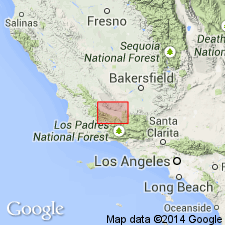
- Usage in publication:
-
- Pato red member*
- Modifications:
-
- Named
- Dominant lithology:
-
- Clay
- Redbeds
- AAPG geologic province:
-
- Transverse Ranges province
Summary:
Named for Pato Canyon, east of Santa Barbara Canyon, Cuyama Valley, Santa Barbara Co, CA as basal member of Vaqueros formation of Monterey group. Consists of lower bed of gray and red clay (800 ft thick) and upper beds of brilliant crimson color (500 ft thick). Overlies with fault contact pre-Monterey shale. Underlies massive white sandstone of Vaqueros formation (of early Miocene age). Map legend gives age as Miocene.
Source: GNU records (USGS DDS-6; Menlo GNULEX).

- Usage in publication:
-
- Pato Red Member†
- Modifications:
-
- Abandoned
- AAPG geologic province:
-
- Transverse Ranges province
Summary:
Redbeds of Pato Red Member of Vaqueros Formation of English (1916) were assigned to Caliente Formation by Hill and others (1958). This usage is retained, and name Pato is considered obsolete. These beds contain sparse mammalian remains that suggest Arikareean age (J.G. Vedder, oral commun., 1968).
Source: GNU records (USGS DDS-6; Menlo GNULEX).
For more information, please contact Nancy Stamm, Geologic Names Committee Secretary.
Asterisk (*) indicates published by U.S. Geological Survey authors.
"No current usage" (†) implies that a name has been abandoned or has fallen into disuse. Former usage and, if known, replacement name given in parentheses ( ).
Slash (/) indicates name conflicts with nomenclatural guidelines (CSN, 1933; ACSN, 1961, 1970; NACSN, 1983, 2005, 2021). May be explained within brackets ([ ]).

